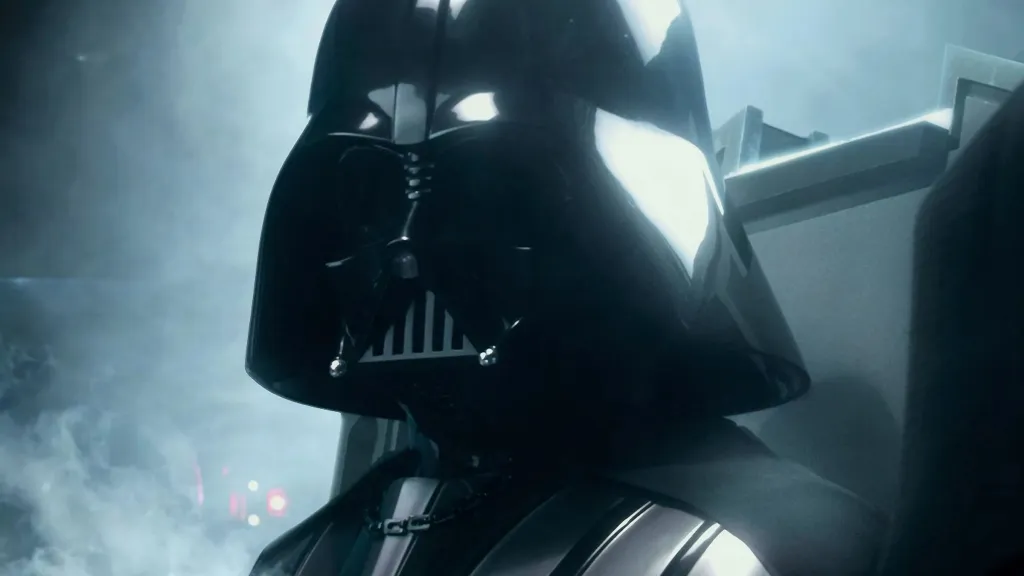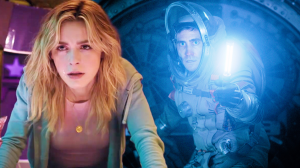In Star Wars: Revenge of the Sith, Anakin Skywalker turns to the dark side and becomes Darth Vader. Though Anakin and Vader are one and the same, they’re treated as separate entities. From a certain point of view, Anakin died when he betrayed the Jedi, giving birth to Vader. But even though the prequel trilogy ends with Vader established as Palpatine’s apprentice, the former hadn’t truly become a Sith yet. It’s not until a critical moment late in the new Star Wars novel Master of Evil that Vader completes his transformation, leaving behind the identity of Anakin Skywalker once and for all in the name of pursuing tremendous power. What’s more is this particular moment sheds some light on the inner workings of the dark side and its corruption of Vader’s grandson Kylo Ren.
Videos by ComicBook.com
Master of Evil is set roughly a couple of years after the events of Revenge of the Sith. In the early days of the Empire, Vader is still consumed by his desire to learn the truth behind Darth Plagueis and how he cheated death, believing there are dark side secrets that will help him bring his late wife Padmé back. Ironically, it’s an interaction between Padmé and Vader that forces the latter to realize it’s time for him to turn the page and embrace the way of the Sith.
Vader Was Haunted By Padmé After Revenge of the Sith

Padmé was Anakin’s reason for turning to the dark side in the first place, so it’s understandable that he’d remain tormented by her death years later. When Master of Evil picks up, Padmé is still Vader’s primary motivation for being. In an early scene in the book, Vader expresses impatience, feeling Palpatine has not yet delivered on his promises. To the Empire, Vader is the Emperor’s right hand, a symbol of fear and terror, but it’s clear in his conversation with Palpatine that parts of Anakin are still coming through. The Emperor is displeased with this; for his own benefit, he needs Vader (not Anakin) to realize his full potential and become stronger in the dark side. So, in typical Palpatine fashion, he manipulates his apprentice by sending Vader on a mission that becomes the book’s main focus.
Palpatine tasks Vader with traveling to the planet Diso, home to a powerful Force shaman. He makes a point to refer to the shaman as a “resurrectionist,” undoubtedly sparking hope within Vader that the shaman could bring Padmé back from the dead. What transpires afterwards is probably what Palpatine foresaw when he gave Vader this particular assignment. After finding the shaman and learning the location of the ancient Temple of Diso (which, in a prologue, was literally removed from the planet and placed inside a ship by Count Dooku), Vader goes rogue and seeks the temple out for himself. Once inside, Vader comes across a dark side vergence and enters a Force void, where he sees various images of his past. One of these visions is a manifestation of Padmé, which is what finally convinces Vader to kill Anakin.
While Vader is in the void, the manifestation of Padmé says to him, “The past is another place. It is a place you cannot conquer, a place you can only destroy. That’s the only way to become what you were meant to be.” While not a direct quote, the passage lifts from Kylo Ren’s famous line in Star Wars: The Last Jedi, where he tries to convince Rey that killing the past is “the only way to become what you are meant to be.” Upon hearing this, Vader comes to the conclusion that Padmé is right and realizes the only way he can tap into the full power of the dark side is by moving on from Anakin’s past. He stabs Padmé with his lightsaber (imagery that evokes Kylo Ren killing Han Solo), an act that would have been inconceivable for Anakin, but necessary for Vader. The text reading, “Anakin Skywalker is dead. Darth Vader lives,” confirms this is the exact moment Vader laid Anakin to rest.
The ending of Master of Evil strongly hints this is what Palpatine intended all along. Meeting with his master, Vader presents the Emperor with a piece of rubble from the Temple of Diso and says, “Here is your temple.” Palpatine’s only reaction is to laugh, indicating that he never wanted to access the temple himself. Instead, he saw an opportunity to set Vader back on the right track, pushing the right buttons to make his apprentice fulfill his destiny. His response to Vader’s return implies he knows what happened at the temple, and he is more than happy with the results. As seen in the sequel trilogy, Palpatine knows how to cheat death, but he was never interested in sharing those secrets with Vader. He just wanted to use Vader as a tool for his own purposes, and now he no longer has to worry about Vader’s fascination with Darth Plagueis. Anakin is no more. There is only Vader.
Master of Evil Sheds Light on How the Dark Side Works

Vader encountering a Force manifestation of Padmé would be fascinating enough, but the scene fleshes out the inner workings of the dark side and how it corrupts people. “Let the past die. Kill it if you have to” is not an original mantra Kylo Ren came up with on his own. It appears to be a general sentiment the dark side tells Force users in an effort to draw them further and further away from the light. Much is made about the Jedi’s restriction against forming attachments, but the dark side has its own spin on that idea. It pushes people to kill (literally in Kylo Ren’s case, metaphorically in Vader’s case) their past in order to leave their old life behind and embark on a new path. The dark side views connections as a hindrance, and if those you care about are no longer around, there’s nothing left other than the pursuit of more power.
Kylo Ren didn’t visit the Temple of Diso, but it stands reason to believe he may have had similar Force visions after he decided to turn. In Star Wars: The Force Awakens, Kylo feels “the pull of the light,” and he believes that killing Han Solo will strengthen him. Decades prior, his grandfather believed symbolically killing the vision of Padmé was his step to achieving ultimate power. The dark side convinces people to become less human by not just eschewing prior attachments but pushing them to remove them entirely from the equation. Vader’s quest to the Temple of Diso could serve as a suitable in-universe explanation for why he isn’t concerned with Padmé during the events of Star Wars: A New Hope; at that point, he had fully moved on from Anakin’s life. It wasn’t until he encountered Luke that he came back to the light.
The dark side’s insistence that the past is something meant to be destroyed lends a lot of credence to Obi-Wan’s infamous “from a certain point of view” explanation for why he never told Luke the truth about Darth Vader. People are twisted by the dark side until they essentially become someone else. Anakin Skywalker would never hurt Padmé, but she means nothing to Darth Vader. All Vader desires is power, which is perfect for Palpatine. As the Sith Rule of Two dictates, “the master’s strength and power come from the anger and fear of his apprentice.” In order for Palpatine to realize his full potential and become the ultimate master of the dark side, he needed Vader, not Anakin.
What do you think? Leave a comment below and join the conversation now in the ComicBook Forum!









